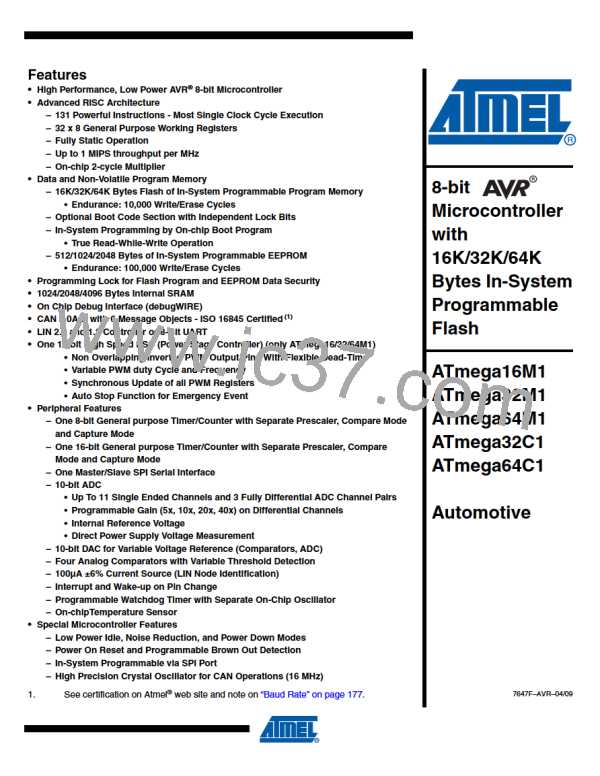16. Controller Area Network - CAN
The Controller Area Network (CAN) protocol is a real-time, serial, broadcast protocol with a very
high level of security. The ATmega16/32/64/M1/C1 CAN controller is fully compatible with the
CAN Specification 2.0 Part A and Part B. It delivers the features required to implement the ker-
nel of the CAN bus protocol according to the ISO/OSI Reference Model:
• The Data Link Layer
- the Logical Link Control (LLC) sublayer
- the Medium Access Control (MAC) sublayer
• The Physical Layer
- the Physical Signalling (PLS) sublayer
- not supported - the Physical Medium Attach (PMA)
- not supported - the Medium Dependent Interface (MDI)
The CAN controller is able to handle all types of frames (Data, Remote, Error and Overload) and
achieves a bitrate of 1 Mbit/s.
16.1 Features
• Full Can Controller
• Fully Compliant with CAN Standard rev 2.0 A and rev 2.0 B
• 6 MOb (Message Object) with their own:
– 11 bits of Identifier Tag (rev 2.0 A), 29 bits of Identifier Tag (rev 2.0 B)
– 11 bits of Identifier Mask (rev 2.0 A), 29 bits of Identifier Mask (rev 2.0 B)
– 8 Bytes Data Buffer (Static Allocation)
– Tx, Rx, Frame Buffer or Automatic Reply Configuration
– Time Stamping
• 1 Mbit/s Maximum Transfer Rate at 8 MHz
• TTC Timer
• Listening Mode (for Spying or Autobaud)
16.2 CAN Protocol
The CAN protocol is an international standard defined in the ISO 11898 for high speed and ISO
11519-2 for low speed.
16.2.1
Principles
CAN is based on a broadcast communication mechanism. This broadcast communication is
achieved by using a message oriented transmission protocol. These messages are identified by
using a message identifier. Such a message identifier has to be unique within the whole network
and it defines not only the content but also the priority of the message.
The priority at which a message is transmitted compared to another less urgent message is
specified by the identifier of each message. The priorities are laid down during system design in
the form of corresponding binary values and cannot be changed dynamically. The identifier with
the lowest binary number has the highest priority.
168
ATmega16/32/64/M1/C1
7647F–AVR–04/09

 ATMEL [ ATMEL ]
ATMEL [ ATMEL ]